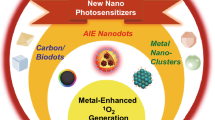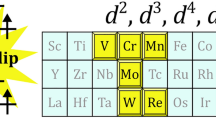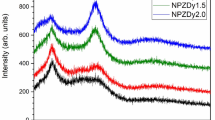Abstract
Interaction between upconverting nanoparticles and aluminum octacarboxyphthalocyanine was studied. The efficiency of non-radiative energy transfer from the nanoparticles to phthalocyanine increased with the number of phthalocyanine molecules adsorbed on the nanoparticle, but only up to a certain limit. Further increase in the phthalocyanine concentration resulted in a decrease of its sensitized fluorescence due to the dimerization of dye molecules on the nanoparticle surface. When subjected to infrared irradiation, phthalocyanine molecules in the hybrid complex generated singlet oxygen. The observed effects are of interest in regard to the targeted search for new components of efficient third-generation hybrid photosensitizers.
Similar content being viewed by others
Abbreviations
- (Al)Pc:
-
(aluminum) phthalocyanine
- PDT:
-
photodynamic therapy
- RNO:
-
p-nitrosodimethylaniline
- ROS:
-
reactive oxygen species
- TCSPC:
-
time-correlated single photon counting
- (UC)NP:
-
(upconverting) nanoparticle
References
Chen, G., Qiu, H., Prasad, P. N., and Chen, X. (2014) Upconversion nanoparticles: design, nanochemistry, and applications in theranostics, Chem. Rev., 114, 5161–5214; doi: https://doi.org/10.1021/cr400425h.
Auzel, F. (2004) Upconversion and anti-stokes processes with f and d ions in solids, Chem. Rev., 104, 139–173; doi: https://doi.org/10.1021/cr020357g.
Wurth, C., Kaiser, M., Wilhelm, S., Grauel, B., Hirsch, T., and Resch-Genger, U. (2017) Excitation power dependent population pathways and absolute quantum yields of upconversion nanoparticles in different solvents, Nanoscale. Royal Soc. Chem., 9, 4283–4294; doi: https://doi.org/10.1039/C7NR00092H.
Kuznetsova, Yu. Yu. (2013) Transfer of electron excitation in up-converting nanoparticles containing rare-earth ions, Izvest. Samarskogo Nauch. Tsentra RAN, 15, 112–115.
Chen, Y., and Liang, H. (2014) Applications of quantum dots with upconverting luminescence in bioimaging, J. Photochem. Photobiol. B Biol., 135, 23–32; doi: https://doi.org/10.1016/j.jphotobiol.2014.04.003.
Generalova, A. N., Chichkov, B. N., and Khaydukov, E. V. (2017) Multicomponent nanocrystals with anti-stokes luminescence as contrast agents for modern imaging techniques, Adv. Colloid Interface Sci., 245, 1–19; doi: https://doi.org/10.1016/j.cis.2017.05.006.
Fong, L. S. E., Chatterjee, D. K., and Zhang, Y. (2009) Use of upconverting nanoparticles in photodynamic therapy (URL: http://www.nus.edu.sg).
Wang, C., Tao, H., Cheng, L., and Liu, Z. (2011) Near-infrared light induced in vivo photodynamic therapy of cancer based on upconversion nanoparticles, Biomaterials, 32, 6145–6154; doi: https://doi.org/10.1016/j.biomaterials.2011.05.007.
Rocheva, V. V., Sholina, N. V., Derevyashkin, S. P., Generalova, A. N., Nechaev, A. V., Khochenkov, D. A., Semchishen, V. A., Khaidukov, E. V., Stepanova, E. V., and Panchenko, V. Ya. (2016) Luminescent diagnostics of tumors using up-conversion nanoparticles, Al’manakh Klin. Med., 44, 227–233; doi: https://doi.org/10.18786/2072-0505-2016-44-2-227-233.
Dougherty, T. J. (1992) Photochemistry in the treatment of cancer, Adv. Photochem., 17, 275–311.
Spiller, W., Kliesch, H., Wohrle, D., Hackbarth, S., Roder, B., and Schnurpfeil, G. (1998) Singlet oxygen quantum yields of different photosensitizers in polar solvents and micellar solutions, Porphyr. Phthalocyanines, 2, 145–158; doi: https://doi.org/10.1002/(SICI)1099-1409(199803/04)2:2<145::AID-JPP60>3.0.CO;2-2.
Ishii, K. (2012) Functional singlet oxygen generators based on phthalocyanines, Coord. Chem. Rev., 256, 1556–1568, doi: https://doi.org/10.1016/j.ccr.2012.03.022.
Taquet, J.-P., Frochot, C., Manneville, V., and Barberi-Heyob, M. (2007) Phthalocyanines covalently bound to biomolecules for a targeted photodynamic therapy, Curr. Med. Chem., 14, 1673–1687; doi: https://doi.org/10.2174/092986707780830970.
Cakir, D., Goksel, M., Cakir, V., Durmus, M., Biyiklioglu, Z., and Kantekin, H. (2015) Amphiphilic zinc phthalocyanine photosensitizers: synthesis, photophysicochemical properties and in vitro studies for photodynamic therapy, Dalt. Trans., 44, 9646–9658; doi: https://doi.org/10.1039/C5DT00747J.
Ribeiro, A. P. D., Andrade, M. C., Bagnato, V. S., Vergani, C. E., Primo, F. L., Tedesco, A. C., and Pavarina, A. C. (2015) Antimicrobial photodynamic therapy against pathogenic bacterial suspensions and biofilms using chloro-aluminum phthalocyanine encapsulated in nanoemulsions, Lasers Med. Sci., 30, 549–559; doi: https://doi.org/10.1007/s10103-013-1354-x.
Strakhovskaya, M. G., Antonenko, Yu. N., Pashkovskaya, A. A., Kotova, E. A., Kireev, V., Zhukhovitskii, V. G., Kuznetsova, N. A., Yuzhakova, O. A., Negrimovskii, V. M., and Rubin, A. B. (2009) Electrostatic binding of substituted metal phthalocyanines to enterobacteria cells: its role in photodynamic inactivation, Biochemistry (Moscow), 74, 1305–1314; doi: https://doi.org/10.1134/S0006297909120025.
Suchan, A., Nackiewicz, J., Hnatejko, Z., Waclawek, W., and Lis, S. (2009) Spectral studies of zinc octacarboxy-phthalocyanine aggregation, Dyes Pigments, 80, 239–244; doi: https://doi.org/10.1016/j.dyepig.2008.06.009.
Makarov, D. A., Kuznetsova, N. A., Yuzhakova, O. A., Savvina, L. P., Kaliya, O. L., Lukyanets, E. A., Negrimovskii, V. M., and Strakhovskaya, M. G. (2009) Effect of the degree of substitution on the physicochemical properties and photodynamic activity of zinc and aluminum phthalocyanine polycations, Russ. J. Phys. Chem. A, 83, 1044–1050; doi: https://doi.org/10.1134/S0036024409060326.
Mackenzie, L. E., Goode, J. A., Vakurov, A., Nampi, P. P., Saha, S., Jose, G., and Millner, P. A. (2018) The theoretical molecular weight of NaYF4:RE upconversion nanoparticles, Sci. Rep. Springer US, 8, 1–11; doi: https://doi.org/10.1038/s41598-018-19415-w.
Kraljic, I., and Moshni, S. E. (1978) A new method for the detection of singlet oxygen in aqueous solutions, Photochem. Photobiol., 28, 577–581; doi: https://doi.org/10.1111/j.1751-1097.1978.tb06972.x.
Gvozdev, D. A., Maksimov, E. G., Strakhovskaya, M. G., Ivanov, M. V., Pashchenko, V. Z., and Rubin, A. B. (2017) The effect of ionic strength on spectral properties of quantum dots and aluminum phthalocyanines, Nanothech. Russ., 12, 73–85; doi: https://doi.org/10.1134/S1995078017010050.
Kadish, K. M., Smith, K. M., and Guilard, R. (2003) The Porphyrin Handbook. Vol. 17. Phthalocyanines: Properties and Materials, Academic Press, San Diego.
Goncalves, P. J., Correa, D. S., Franzen, P. L., De Boni, L., Almeida, L. M., Mendonca, C. R., Borissevitch, I. E., and Zilio, S. C. (2013) Effect of interaction with micelles on the excited-state optical properties of zinc porphyrins and J-aggregates formation, Spectrochim. Acta Part A Mol. Biomol. Spectrosc., 112, 309–317; doi: https://doi.org/10.1016/j.saa.2013.04.065.
Maiti, N. C., Mazumdar, S., and Periasamy, N. (1998) J- and H-aggregates of porphyrin-surfactant complexes: time-resolved fluorescence and other spectroscopic studies, J. Phys. Chem., 102, 1528–1538; doi: https://doi.org/10.1021/jp9723372.
Gandini, S. C. M., Yushmanov, V. E., Borissevitch, I. E., and Tabak, M. (1999) Interaction of the tetra(4-sulfonatophenyl)porphyrin with ionic surfactants: aggregation and location in micelles, Langmuir, 15, 6233–6243; doi: https://doi.org/10.1021/la990108w.
Bednarkiewicz, A., Nyk, M., Samoc, M., and Strek, W. (2010) Up-conversion FRET from Er3+/Yb3+: NaYF4 nanophosphor to CdSe quantum dots, J. Phys. Chem., 114, 17535–17541; doi: https://doi.org/10.1021/jp106120d.
Watkins, Z., Uddin, I., Britton, J., and Nyokong, T. (2017) Characterization of conjugates of NaYF4:Yb,Er,Gd upconversion nanoparticle with aluminum phthalocyanines, J. Mol. Struct., 1130, 128–137; doi: https://doi.org/10.1016/j.molstruc.2016.10.011.
Lakowicz, J. R. (2006) Principles of Fluorescence Spectroscopy, 3rd Edn., Springer, New York.
Su, Q., Feng, W., Yang, D., and Li, F. (2017) Resonance energy transfer in upconversion nanoplatforms for selective biodetection, Acc. Chem. Res., 50, 32–40; doi: https://doi.org/10.1021/acs.accounts.6b00382.
Drees, C., Raj, A. N., Kurre, R., Busch, K. B., Haase, M., and Piehler, J. (2016) Engineered upconversion nanoparticles for resolving protein interactions inside living cells, Angew. Chemie Int. Ed., 55, 11668–11672; doi: https://doi.org/10.1002/anie.201603028.
Resch-Genger, U., and Gorris, H. H. (2017) Perspectives and challenges of photon-upconversion nanoparticles. Part I: Routes to brighter particles and quantitative spectroscopic studies, Anal. Bioanal. Chem., 409, 5855–5874; doi: https://doi.org/10.1007/s00216-017-0499-z.
Komarala, V. K., Wang, Y., and Xiao, M. (2010) Nonlinear optical properties of Er3+/Yb3+-doped NaYF4 nanocrystals, Chem. Phys. Lett., 490, 189–193; doi: https://doi.org/10.1016/j.cplett.2010.03.041.
Author information
Authors and Affiliations
Corresponding author
Ethics declarations
Conflict of interest. The authors declare no conflict of interest in financial or any other sphere.
Ethical approval. This article does not contain any studies with human participants or animals performed by any of the authors.
Additional information
Russian Text © The Author(s), 2019, published in Biokhimiya, 2019, Vol. 84, No. 8, pp. 1154–1166.
Rights and permissions
About this article
Cite this article
Gvozdev, D.A., Lukashev, E.P., Gorokhov, V.V. et al. Photophysical Properties of Upconverting Nanoparticle–Phthalocyanine Complexes. Biochemistry Moscow 84, 911–922 (2019). https://doi.org/10.1134/S0006297919080078
Received:
Revised:
Accepted:
Published:
Issue Date:
DOI: https://doi.org/10.1134/S0006297919080078




